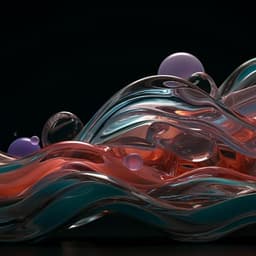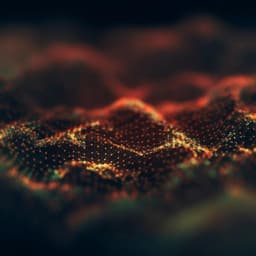
Medicine and Health
Large-scale perfused tissues via synthetic 3D soft microfluidics
S. Grebenyuk, A. R. A. Fattah, et al.
This groundbreaking research by Sergei Grebenyuk and colleagues from KU Leuven unveils a new method for vascularizing engineered tissues and organoids, achieving impressive perfusion in multi-mm³ constructs. The study not only demonstrates the viability and proliferation of these tissues but also shows accelerated neural differentiation, paving the way for complex and scalable human tissue models.
~3 min • Beginner • English
Introduction
Engineered tissues and organoids hold promise for drug discovery and regenerative medicine, but their growth, maturation, and reproducibility are constrained by the absence of an internal vasculature that can support oxygen, nutrient delivery, and waste removal. In vivo most cells reside within ~200 µm of a capillary; exceeding this diffusion limit in vitro leads to hypoxia, apoptosis, and necrotic cores as constructs grow. Prior in vitro vascularization strategies have been unable to provide dense, capillary-scale networks across multi-millimeter constructs with controlled topology and flow. This study addresses the key question of whether synthetic, precisely patterned capillary-scale microfluidic networks can perfuse large 3D tissue constructs to enhance viability and accelerate differentiation while preventing hypoxia and necrosis.
Literature Review
Multiple strategies have been explored to vascularize in vitro tissues: (1) extrinsic induction of angiogenesis via co-culture with endothelial beds or chips that allow vessel sprouting into organoids, including in vivo grafting and transcription-factor-driven endothelialization. These enhance growth but offer limited control over flow rates and network topology, and organoids remain small. (2) Artificial vessel templating through layer-by-layer deposition of gels (filaments, droplets), stereolithography, or multiphoton lithography, and sacrificial templates removed post-fabrication. Kenzan needle arrays form 150–200 µm channels after needle removal. Laser photoablation creates channels in hydrogels. Despite versatility, integrated perfusable engineered vessels have been limited to diameters ≥150 µm, constraining tissue dimensions (often ≤400–500 µm in at least one dimension) and preventing physiologically relevant signaling and complexity. This work builds on multiphoton approaches by integrating capillary-scale (down to ~10 µm) vessels into a complete, perfusable platform that supports large tissues.
Methodology
Materials and device fabrication: The team formulated a custom, hydrophilic, non-swelling photo-polymerizable resin for 2-photon stereolithography to print permeable, capillary-scale microfluidic grids directly onto rigid plastic baseplates to ensure leak-free sealing. Resin composition: 2% Irgacure 369 (photoinitiator), 7% PGMEA, 36% PEGDA 700, 25% PETA (crosslinker), 20% Triton X-100 (porosity enhancer), 10% water. After water equilibration, rheology showed storage modulus G' ≈ 250 kPa, loss modulus an order of magnitude lower; water content ~34%. Printing was performed on a Nanoscribe GT2 system. The grids were produced with high CAD-to-print fidelity (1:1) and ~90% success rate.
Microfluidic grid design: Grids (typical 2.6 × 2.6 × 1.5 mm; range up to 6.5 × 6.5 × 5 mm) contained parallel capillaries with diameters ~10–>70 µm, wall thickness 2–10 µm, and inter-capillary spacing 250 µm to keep cells within diffusion limits. Fluorescein (25 µM) perfusion tests in Matrigel confirmed rapid diffusion across capillary walls, saturating the gel within ~10 minutes. Grids were fabricated directly on custom baseplates (1 mm thick, 10 mm diameter, 0.5 mm perfusion holes) 3D-printed in biocompatible resin and extensively solvent-washed; grid inlets were aligned to baseplate perfusion holes.
Perfusion chip: Two grids were sandwiched between profiled PDMS blocks and clamped with metal plates and coverslips to form sealed channels. A peristaltic pump circulated culture medium from a reservoir through non-perfused and perfused chambers in series, then back to the reservoir for gas equilibration. A 0.22 µm inline filter prevented clogging. Typical initial flow rate set to ~400 µL/min. An 8-grid multiplexed chip with equalized channel resistances allowed simultaneous perfusion of up to eight grids.
Cell seeding and neural tissue formation: hPSC spheroids (<200 µm) were generated in microwells/Aggrewell plates (350–400 cells per microwell), aggregated 24 h in pluripotency medium, grown to ~180–200 µm by day 2, and suspended in cold growth factor-reduced Matrigel (GFR Matrigel). Approximately 1,800 spheroids were seeded per grid (∼3,500 spheroids per 200–250 µL) under a stereomicroscope, gelled, and connected to perfusion. Neural induction started at day 6 using DMEM/F12-based induction medium with N2 and heparin; tissues were characterized at day 8.
Single-cell RNA-seq: After 8 days, cells from perfused and non-perfused grids and from conventional suspension organoids (controls) were dissociated (TrypLE). 10x Genomics Chromium Single Cell 3' v3 libraries were prepared and sequenced. Data processing used CellRanger and Seurat v3 with QC filtering (>15% mitochondrial reads removed; genes per cell <200 or >7500 removed). 13,075 cells were sequenced; 8,625 cells retained post-QC (average 1,852 genes/cell). Dimensionality reduction used PCA and UMAP; clustering used graph-based methods (FindNeighbors with top 15 PCs; FindClusters at resolution 0.5). Pseudotime analysis used Monocle 3. Gene-set scoring assessed pluripotency, glycolysis, and neural progenitor programs. GO enrichment compared perfused versus non-perfused constructs.
Imaging and immunohistochemistry: Tissues were fixed (4% PFA), sectioned (vibratome or cryosection), and stained for markers including cleaved Caspase-3 (apoptosis), HIF1α (hypoxia), pluripotency (NANOG), neuroepithelium (PAX6), adhesion (E-Cadherin/CDH1, N-Cadherin/CDH2), and neural maturation (SOX2, DCX, NeuN, MBP, BLBP). Image analysis used Fiji/ImageJ with custom plugins; expression quantified as area ratios or mean fluorescence intensity (for HIF1α) normalized across conditions.
Long-term cerebral organoid perfusion: Single pre-differentiated neural spheroids (5 days) were embedded in Matrigel within perfused and non-perfused grids; controls were Matrigel drops in suspension. Cultures were maintained for 62 days, with longitudinal imaging and endpoint immunostaining for apoptotic cores, myelination (MBP), radial glia (BLBP), migrating neurons (DCX), cortical layer markers (TBR1, CTIP2, SATB2), and neurotransmitter phenotypes (GLS, GAD67).
Hepatic tissue constructs and function: hPSC line H3CX (dox-inducible HNF1A, FOXA3, PROX1) was differentiated 8 days in 2D to liver progenitors, aggregated into spheroids, seeded into grids, and perfused for an additional 32 days (comparison with standard 2D hepatocyte differentiation and 3D hepatic organoids). Histology (H&E) and immunostaining assessed hepatocyte phenotype (ALB, AAT, HNF4α), cholangiocytes (KRT19) localization around vessels, transporters (MRP2, NTCP), CYP450s (CYP3A4), and progenitor markers (AFP). Albumin and urea secretion were quantified at day 50.
Drug metabolism assays: Perfused hepatic constructs were dosed with quinidine (CYP3A4), metoclopramide (CYP2D6), or theophylline (CYP1A2) at 1 µM (single drug at a time). Medium samples were collected over time and analyzed by LC-MS/MS. Drug half-life and apparent intrinsic clearance were calculated; in vivo clearance predicted via the well-stirred model using standard physiological scaling factors (SF = 107 million cells/g liver; liver weight 26 g/kg; hepatic blood flow 21 ml/min/kg).
Key Findings
- Printing and material performance: A custom non-swelling PEGDA/PETA/Triton-X photopolymer enabled precise, leak-free 2-photon printing of permeable capillary networks with diameters down to ~10 µm, wall thickness 2–10 µm, and inter-capillary spacing of 250 µm across multi-mm3 volumes (up to 6.5 × 6.5 × 5 mm). Fluorescein diffused through vessel walls and saturated surrounding gel within ~10 minutes.
- scRNA-seq (day 8): 8,625 cells retained post-QC revealed distinct clustering of perfused, non-perfused, and control organoids. Perfused tissues showed enrichment for neuroepithelial identity (PAX6/7/3, CDH2) and higher proliferation markers (CDC6, MKI67, TOP2A) with decreased hypoxia/stress markers (VEGFA, FOS, HIF1A). Both tissue constructs (perfused and non-perfused) showed a metabolic shift from glycolysis to oxidative phosphorylation versus controls; perfused had the strongest neural precursor signatures.
- Viability, hypoxia, apoptosis: Flow cytometry showed similar viability fractions (live cells: 90.9 ± 5.1% perfused vs 89.2 ± 4.4% non-perfused), but a ∼5-fold higher total cell number in perfused constructs. Cleaved Caspase-3 positive area: control organoids 8 ± 1%, non-perfused 35.7 ± 5%, perfused 5.1 ± 1%. HIF1α expression (normalized): control 100 ± 3%, non-perfused 55 ± 3%, perfused 26 ± 2%.
- Early neural differentiation (day 8): PAX6 protein expression: perfused 21.5 ± 2%, non-perfused 0.2 ± 0.2%, control not detected. NANOG: control 73.6 ± 8%, non-perfused 16.1 ± 2%, perfused not detected. Adhesion switch: N-Cadherin (CDH2): control 100 ± 1%, non-perfused 7.6 ± 1%, perfused 55.7 ± 9%. E-Cadherin (CDH1): control 99 ± 2%, non-perfused 26.6 ± 7%, perfused 4.5 ± 2%.
- Long-term cerebral organoids (62 days): Perfused organoids lacked central apoptotic cores and exhibited myelination (MBP+), extensive radial glia (BLBP+) and neuronal (DCX+) arborization, and evidence of excitatory (GLS+) and inhibitory (GAD67+) microcircuits with bundled processes. Control and non-perfused organoids showed cores with cleaved Caspase-3 and limited arborization; non-perfused displayed thin viable rims.
- Hepatic constructs: Perfused liver tissues formed dense, viable hepatocyte-like tissue without necrosis; cholangiocyte-like KRT19+ cells localized around vessels; hepatocytic markers (ALB, HNF4α) expressed in inter-vessel spaces. Gene expression upregulated vs 2D and organoid controls: HNF6, NTCP, ALB, AAT, CYP2C9, CYP3A4; gluconeogenesis enzymes PEPCK and G6PC increased (1.6× and 1.3× vs organoids). Albumin secretion 97.6 ± 23.1 ng/h/10^6 cells; urea 1.4 ± 0.2 µg/h/10^5 cells.
- Drug clearance prediction (well-stirred model): Quinidine (CYP3A4): predicted 10 ml/min/kg vs observed 4.7 (FPE 2.1). Metoclopramide (CYP2D6): predicted 1.5 vs observed 6.2 (FPE 0.2). Theophylline (CYP1A2, low clearance): predicted 0.8 (second application 1.5) vs observed 0.77 (FPE 1.0; second 1.9). High IVIVC particularly for low-clearance theophylline.
Discussion
The study demonstrates that fully synthetic, capillary-scale 3D soft microfluidics can resolve the core limitation of large engineered tissues—diffusion constraints—by providing uniform, permeable, and precisely patterned perfusion across multi-mm3 constructs. The non-swelling photopolymer formulation was critical to achieving high-fidelity, leak-free integration with a perfusion device. Perfusion improved tissue oxygenation and nutrient delivery, reduced hypoxia and apoptosis, and accelerated differentiation trajectories. In neural tissues, perfusion rapidly drove pluripotent cells toward neuroepithelial identity, coincident with a metabolic shift to oxidative phosphorylation, and sustained proliferation with minimal stress signaling. Long-term perfused cerebral organoids exhibited myelination and extensive neural and glial arborization, suggesting enhanced maturation and microcircuit formation compared to non-perfused and conventional cultures. In hepatic constructs, perfusion yielded phenotypic and functional improvements over 2D and organoid controls, including higher expression of hepatic markers, metabolite production, and predictive drug clearance—especially for low-turnover compounds—highlighting utility for pharmacokinetic assessment. Collectively, these findings confirm that engineered, permeable microvasculature can reproducibly perfuse large tissues, enhance viability and differentiation, and provide a scalable, flexible platform for advanced in vitro models.
Conclusion
This work introduces a synthetic vascularization platform that uses 2-photon-printed, non-swelling hydrogel capillary networks to perfuse large, multi-mm3 engineered tissues. The platform maintains high viability, suppresses hypoxia and apoptosis, and accelerates neural differentiation, while supporting long-term maturation of cerebral organoids with myelination and complex arborization. Perfused hepatic constructs display enhanced hepatic gene expression, metabolic function, and strong IVIVC for low-clearance drug metabolism. The approach affords precise control over vascular topology and is compatible with various extracellular matrices, enabling broadly applicable, large-scale perfused tissue models. Future work could incorporate engineered degradability and endothelialization of channels, adjust inter-capillary spacing to restore zonation or cortical layering, and integrate spatially patterned biochemical and mechanical cues to impose defined developmental patterning.
Limitations
While enabling perfusion at unprecedented resolution and scale, the platform does not recapitulate adaptive vascular features of in vivo systems (e.g., vascular remodeling, barrier selectivity). The regular, tightly spaced capillary topology provides uniform oxygen/nutrient delivery that may diminish tissue zonation (liver) or layered organization (cortex) unless geometries are modified. Endothelial cells were not seeded in channels in the presented datasets, limiting biomimicry of vascular-tissue interactions. Experimental design notes include absence of blinding and no predetermined sample size. Further optimization of flow parameters, inter-capillary distance, and incorporation of vascular and stromal cell types may be required to model tissue-specific architecture and function more faithfully.
Related Publications
Explore these studies to deepen your understanding of the subject.







